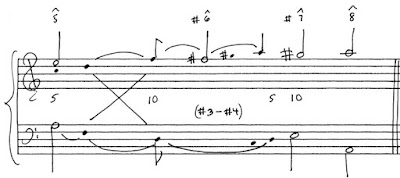The progressions I used in the earlier post were short formulas; this is an entire binary-form composition of more than 50 bars. There are four elements: A1, bars 1-15, PAC in E minor; A2, bars 16-28, PAC in E minor; B1, bars 29-42, PAC in A minor; B2, bars 43-54, PAC in A minor. Here it is on the Monuments of Partimenti website, among a rather large number of examples with first inversion seventh chords (6/5s): link.
In the first section, it is easy to hear a middleground upper voice descending from ^5, interrupted in the cadence:
For my detailed example, I will use the final section (B2, bars 43-54). An almost entirely stepwise melodic line comfortably fits Durante's bass, although I took one liberty in assuming iv6 rather than VI in bar 50:
Here are the final five measures realized in three voices.
At first glance, an incomplete line (or what I have elsewhere called a "primitive line") fits with the bass of figure g (that is, i-i6-iiø6/5-V-i), but neither i6 nor iiø6/5 support a tone at the same level as the others.
A better, musically more satisfying solution gives due prominence to the subdominant in both its minor and major forms. Underlying this is a simpler variant of figure b (with IV, not IV followed by ii).







